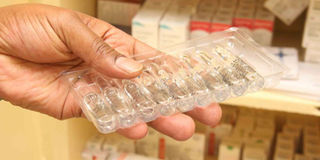How to make cash burden lighter for cancer patients

Cancer medication. Cancer care is an expensive affair. Its treatment can set back the patient up to Sh7 million. PHOTO | FOTOSEARCH
Cancer incidence is expected to rise by 70 per cent in the next two decades. The mortality expected to be disproportionately higher compared to other countries, due to the ill-preparedness of our healthcare system.
In a disease narrative, curative solutions are likely to dominate over the counterpart preventive options. In the event that preventive options are explored, eating a healthy diet and being active would surface as suggestions. The underlying hypothesis is that such healthy habits would bolster one’s immune system to help keep diseases at bay.
Curative solutions work on the same foundation; artificial addition of substance into one’s body to boost one’s immune system, and aid the fight against diseases. The main difference, however, is the financial burden to the individual. Preventive solutions are considered more cost effective and could avert up to 50 per cent of cancer cases today.
Policy interventions in support of preventive solutions will be of benefit to the society. Not only will this enlighten the society and protect them from the disease, but also shield them from financial strains.
Cancer care is an expensive affair. Its treatment can set back the patient up to Sh7 million. Kenya is fortunate to have a wide array of prepayment mechanisms that could be used to meet such costs. But to what extent?
NHIF, the most pervasive insurance scheme in terms of number of principal members, covers up to Sh900,000 of cancer related treatment costs. Private insurance companies have varied upper limits, but are typically capped at Sh1 million. Assuming a breast cancer patient has both covers, she is left with the burden of raising 70 per cent of her costs from out of pocket means, in order to access quality of cancer care treatment. This would result in the patient digging deeper into her already stretched pockets, selling part of her property and fund raising.
EXTERNAL FUNDING
It is recommended that no more than 15 — 20 per cent of total health expenditure should be met through out-of-pocket payments in order to prevent pushing individuals and households into poverty. In Kenya, about 30 per cent of healthcare costs are met out-of-pocket, an increase from the 27 per cent reported by World Bank in 2016. This could be due to a situation where external funding and government investment into healthcare have not only been on a decline, but have also fallen below the recommended levels.
For instance, whereas research recommends US$86 (Sh8,650) as the minimum general government health expenditure (GGHE) per capita needed to promote universal healthcare (UHC), latest evidence shows Kenya’s GGHE per capita stands at US$24 — falling far short of this threshold and Africa’s average.
Similarly, GGHE as a proportion of gross domestic product (GDP) is a generally used threshold to assess commitment of a government to promote UHC. Whereas five per cent is the recommended minimum threshold for this indicator, Kenya invests less than two per cent of its GDP in health.
The limited fiscal space for health in Kenya drives the high levels of out-of-pocket payments. By 2030, at least two million Kenyan households will be impoverished by out-of-pocket payments should the financing situation prevail.
There is so much that can be done to ensure the cancer incidence goes down, including vaccines and other technologies being discovered. The bottom line is, raising awareness and advocating prevention through a reduction in exposure to risk factors.
The government has an obligation to increase its fiscal allocation towards prevention and treatment of cancer, as well as facilitating the provision of alternative financial protection mechanisms to cushion those already diagnosed with the disease.
Waruguru is a corporate finance specialist at E&K Consulting Firm, email: [email protected]
Bonareri is a business analyst at E&K Consulting Firm


